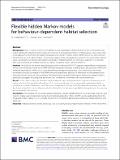Flexible hidden Markov models for behaviour-dependent habitat selection
Abstract
Background There is strong incentive to model behaviour-dependent habitat selection, as this can help delineate critical habitats for important life processes and reduce bias in model parameters. For this purpose, a two-stage modelling approach is often taken: (i) classify behaviours with a hidden Markov model (HMM), and (ii) fit a step selection function (SSF) to each subset of data. However, this approach does not properly account for the uncertainty in behavioural classification, nor does it allow states to depend on habitat selection. An alternative approach is to estimate both state switching and habitat selection in a single, integrated model called an HMM-SSF. Methods We build on this recent methodological work to make the HMM-SSF approach more efficient and general. We focus on writing the model as an HMM where the observation process is defined by an SSF, such that well-known inferential methods for HMMs can be used directly for parameter estimation and state classification. We extend the model to include covariates on the HMM transition probabilities, allowing for inferences into the temporal and individual-specific drivers of state switching. We demonstrate the method through an illustrative example of plains zebra (Equus quagga), including state estimation, and simulations to estimate a utilisation distribution. Results In the zebra analysis, we identified two behavioural states, with clearly distinct patterns of movement and habitat selection (“encamped” and “exploratory”). In particular, although the zebra tended to prefer areas higher in grassland across both behavioural states, this selection was much stronger in the fast, directed exploratory state. We also found a clear diel cycle in behaviour, which indicated that zebras were more likely to be exploring in the morning and encamped in the evening. Conclusions This method can be used to analyse behaviour-specific habitat selection in a wide range of species and systems. A large suite of statistical extensions and tools developed for HMMs and SSFs can be applied directly to this integrated model, making it a very versatile framework to jointly learn about animal behaviour, habitat selection, and space use.
Citation
Klappstein , N J , Thomas , L & Michelot , T 2023 , ' Flexible hidden Markov models for behaviour-dependent habitat selection ' , Movement Ecology , vol. 11 , 30 . https://doi.org/10.1186/s40462-023-00392-3
Publication
Movement Ecology
Status
Peer reviewed
ISSN
2051-3933Type
Journal article
Collections
Items in the St Andrews Research Repository are protected by copyright, with all rights reserved, unless otherwise indicated.

